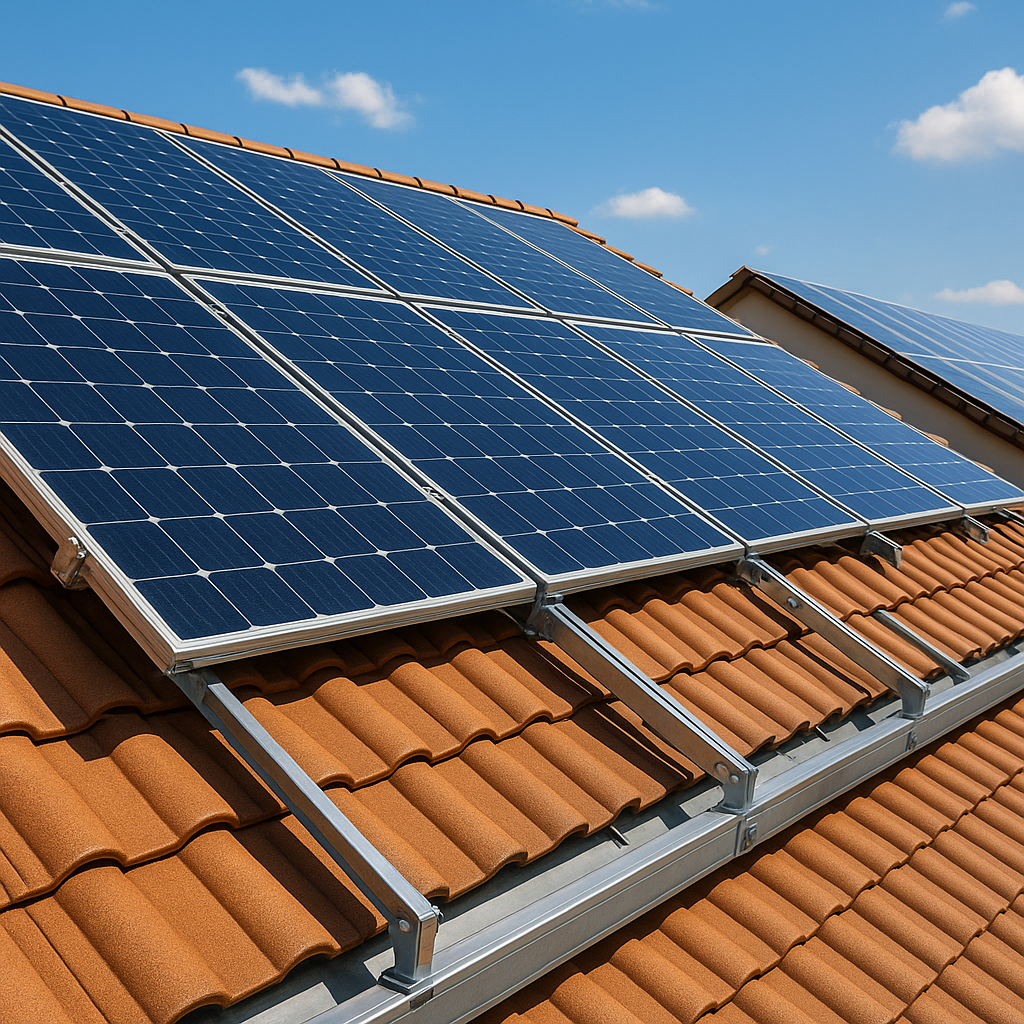17 Game-Changing Solar Module Mounting Structures to Maximize Energy Output in 2025

A solar module mounting structure is the engineered framework that holds solar panels in place, ensuring optimal angle and durability. From small homes to utility-scale solar farms, these structures are critical to maintaining performance and safety.
Often referred to as solar racking systems or PV mounting systems, these solutions affect everything from energy efficiency to installation cost. Without a well-designed mounting framework, even the most advanced solar panels can underperform due to poor sun exposure or structural instability.
Key Components of a Solar Panel Mounting Solution
To support long-term energy output, a solar panel mounting structure includes several essential components:
-
Support rails and beams: Provide the horizontal base for panel placement
-
Clamps and brackets: Secure panels to the racking system
-
Tilt frames or brackets: Set the panel at the ideal angle
-
Anchors and bases: Attach the system to roofs, poles, or the ground
-
Fasteners and grounding systems: Ensure structural safety and electrical compliance
These parts work together to form a stable, efficient photovoltaic support structure.
Fixed Tilt Mounting Systems
Fixed solar panel mounts are simple, durable, and cost-effective. They hold panels at a set angle throughout the year.
Advantages:
-
Low cost
-
Minimal maintenance
-
Ideal for areas with consistent solar patterns
Best For: Large ground-mounted solar systems or static commercial arrays
Adjustable Tilt Mounting Systems
This system allows you to change the tilt angle based on seasons, maximizing sun exposure.
Variants:
-
Manual Adjustable: Adjusted manually 2–4 times annually
-
Motorized Adjustable: Controlled via timers or sensors
Benefits:
-
Higher energy yield (~10–20%)
-
Helps panels self-clean with rain or snow
Also known as adjustable solar racking, these systems are great for climates with seasonal sun variance.
Single-Axis Solar Tracking Systems
Single-axis trackers follow the sun’s east-to-west movement, increasing solar panel exposure.
Key Features:
-
Mounted on rotating steel or aluminum shafts
-
Boosts output by 25–30%
-
Often seen in large-scale PV farms
Solar tracking systems add complexity but deliver significant efficiency gains over the year.
Dual-Axis Solar Tracking Structures
These advanced tracking systems adjust both tilt and azimuth angles, tracking the sun in two dimensions.
Advantages:
-
Energy gains up to 35–40%
-
Ideal for high-value or space-constrained projects
These structures are premium choices in solar installation frameworks where output maximization justifies higher costs.
Ground-Mounted Solar Structures
These systems are installed directly on open land using two main types:
-
Pier-driven racking: Steel piers driven deep into the earth
-
Ballasted solar panel mounts: Use concrete blocks as a non-penetrating foundation
Perks:
-
Easy maintenance access
-
Highly scalable
-
Ideal for rural or industrial areas
Whether fixed or tracking, ground-mounted solar systems are reliable for long-term energy harvesting.
Roof-Mounted Solar Structures
Roof-mounted solar racking systems are perfect for urban or space-limited areas.
Types:
-
Flat Roof Mounts: Use tilt frames or ballast-based systems
-
Sloped Roof Mounts: Attach directly to rafters using flashing and brackets
Pros:
-
Saves land space
-
Utilizes existing infrastructure
Choosing between roof-integrated PV systems and surface-mount racking depends on roof design and materials.
Pole-Mounted Solar Structures
Great for off-grid, rural, or mobile systems, pole-mounted structures come in two formats:
-
Top-of-pole mounts
-
Side-of-pole mounts
These elevated PV support systems provide ground clearance and are adjustable for tilt.
Best For: Agricultural applications, remote monitoring stations, or standalone power units.
Floating Solar Mounting Structures
Installed on floating platforms, these floating PV systems are increasingly used on lakes and reservoirs.
Advantages:
-
Saves land
-
Cools panels naturally, improving performance
-
Reduces water evaporation
Drawbacks: Complex engineering and limited installation zones
A growing trend in land-scarce regions, especially for large utilities.
Carport Solar Mounting Structures
These structures combine elevated PV mounting systems with vehicle parking.
Highlights:
-
Dual-use: shelter + power generation
-
Easy integration with EV charging
-
Popular in malls, schools, and office parks
An excellent solution for organizations looking to enhance sustainability and space efficiency.
Building-Integrated Photovoltaic (BIPV) Structures
BIPV systems embed solar panels into architectural elements—walls, facades, or roofs.
Benefits:
-
Seamless aesthetic
-
No need for extra space
Limitations:
-
Lower efficiency
-
Higher cost and customization requirements
These structural solar mounting options are ideal for eco-architectural projects.
Material Selection for Mounting Structures
Choosing the right material directly affects strength, longevity, and ROI.
| Material | Benefits | Ideal Use |
|---|---|---|
| Aluminum | Lightweight, rust-resistant | Roof mounts, corrosive areas |
| Galvanized Steel | Strong, budget-friendly | Ground systems, large commercial use |
| Stainless Steel | Extremely durable, weather-resistant | Seismic or harsh weather zones |
Quality materials make or break your solar module mounting structure’s reliability.
Factors Influencing Mounting Structure Design
Before selecting your solar racking system, consider:
-
Wind and Snow Load: Determines support strength and tilt angle
-
Seismic Risk: Affects foundation design and anchoring
-
Terrain and Soil Type: Influences base choice (pier vs ballast)
-
Roof Shape and Strength: Critical for roof-mounted solar racking
Professional evaluation helps prevent costly retrofits.
Cost Considerations and Return on Investment
Installation Costs:
-
Fixed tilt: $0.10–$0.20/W
-
Adjustable and tracking systems: Up to $0.40/W
Factors Influencing ROI:
-
Increased output from tracking or tilt adjustment
-
Reduced land or building costs
-
Long-term energy savings and tax credits
Choosing the right solar panel mounting solution can dramatically improve financial payback.
Installation and Maintenance Guidelines
Best Practices:
-
Ensure proper grounding and bonding
-
Use corrosion-resistant coatings
-
Install with recommended torque and spacing
Maintenance Checklist:
-
Inspect joints, brackets, and supports
-
Clean panel surfaces biannually
-
Check tilt angles and hardware tightness
A well-maintained solar module mounting structure can last over 30 years.
Future Trends in Solar Mounting Structures
The solar industry is rapidly evolving. Expect:
-
AI-Optimized Trackers: Adjust angles using predictive weather data
-
Modular Mounting Kits: Easier to install, move, and expand
-
3D-Printed Structures: Custom-fitted brackets and racking
-
Smart Materials: Self-healing, corrosion-proof coatings
These innovations make solar panel mounting systems smarter, lighter, and more efficient.
FAQs About Solar Module Mounting Structures
Q1: What is the most durable type of solar panel mount?
A: Galvanized or stainless-steel ground mounts last the longest under extreme conditions.
Q2: Can solar mounting structures be reused?
A: Yes, especially modular systems. Components can often be relocated or reinstalled.
Q3: Are floating solar racking systems reliable?
A: Yes. With proper engineering, they’re stable and efficient—widely used in Asia and Europe.
Q4: What's better: fixed or adjustable tilt systems?
A: Adjustable systems offer more energy yield but cost more. Choose based on climate and budget.
Q5: Do solar panel mounts require maintenance?
A: Yes—check fasteners, clean panels, and ensure rust prevention measures are in place.
Q6: Are roof-mounted systems safe for old buildings?
A: Only after a structural review. Lightweight aluminum racking is usually preferred.
Conclusion: Choosing the Right Solar Module Mounting Structure
A well-chosen solar module mounting structure is just as crucial as the solar panels themselves. With numerous configurations—roof, ground, pole, floating, and more—there’s a perfect fit for every site, budget, and energy goal.
Whether you're a homeowner, business, or solar developer, using high-quality solar panel mounting solutions can maximize efficiency, ensure durability, and future-proof your solar investment.







